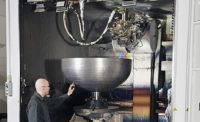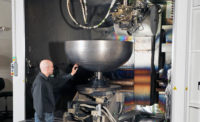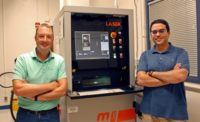BETHESDA, MD—Lockheed Martin is extending its use of MakerBot 3D printers to produce parts and designs for upcoming space projects, including NASA's Artemis program. For one project, being done in alliance with General Motors, Lockheed Martin is developing a new fully autonomous lunar rover that could be used for Artemis. The project pays homage to the original Apollo rover, which GM was also involved in its development.
Some elements of the rover’s autonomy system are being designed and developed at Lockheed’s Advanced Technology Center (ATC) in Palo Alto, CA.
The latest addition to the ATC’s 3D printing lab is the MakerBot METHOD X 3D printing platform. With METHOD X, the team can print parts in materials like Nylon Carbon Fiber and ABS. Also, its heated chamber ensures that the parts are dimensionally accurate without the variable warping that comes with a typical desktop 3D printer.
“At ATC, we have multiple that help with quick turnaround times,” says Aaron Christian, senior mechanical engineer at Lockheed Martin Space. “I will design a part, print it, and have it in my hand hours later. This allows me to quickly test the 3D-printed part, identify weak points, adjust the model, send it back to print overnight, and then have the next iteration in the morning. 3D printing lets me do fast and iterative design, reducing wait times for a part from weeks to hours.”
Christian and his teammates are using METHOD X to print a number of parts for prototyping and proof of concept for the rover project, including embedded systems housing, sensor mounts, and other custom parts. Many parts are designed to withstand desert heat, UV exposure, moisture, and other environmental conditions.
In combination with Stratasys SR-30 soluble supports, parts printed with MakerBot ABS are designed to provide a smoother surface finish compared to breakaway supports. Printing with dissolvable supports also enables more organic shapes that would have been otherwise impossible to produce through traditional machining. 3D printing encourages engineers to think more outside of the box than they have ever before.
“The rover we have at ATC is a testbed that we designed and developed in-house," says Christian. "This modular testbed allows us to make quick changes using 3D printing to change the design for other applications, whether it be military, search and rescue, nuclear applications and just extreme environment autonomy needs.”
One part printed for the rover was a mount for a LIDAR, a sensor that can help determine the proximity of objects around it. The mount is designed to sit on the rover and printed in ABS, which allows it to handle more extreme conditions than typical PLA. The mount also allows engineers to continuously swap out the LIDAR with different sensors, such as a stereo camera, direction antenna, RGB camera, or a rangefinder. It has a complex organic shape to it, which can be difficult to achieve via traditional machining. The mount also has a lot of access to ensure proper airflow to keep the part cool and temperature-regulated on the robots.



